Criminal court statistics quarterly: January to March 2020 (HTML)
Published 25 June 2020
Applies to England and Wales
We are trialling the publication of this statistical bulletin in HTML form at alongside the usual PDF version and we are seeking user feedback on the use of HTML for the publication of statistical bulletins. Please send any comments to: datausers@justice.gov.uk.
Main Points
| Magistrates’ court: large increase in outstanding cases | Receipts remained stable whereas disposals fell by 7% on Q1 2019. As a result, outstanding cases increased by 11%, back to levels previously seen in 2015. |
| Crown Court: decrease in disposals | The number of receipts increased 3% whilst the number of disposals fell by 8% on the previous year. |
| Crown Court: increase in outstanding cases | Outstanding cases increased by 21% on the previous year, from 33,114 to 40,173 cases. |
| Waiting times at Crown Court continue to fall | The median waiting time for all cases reached 5.7 weeks, down 7% compared to Q1 2019 (6.1 weeks) and less than half of the peak seen in Q2 2015 (13.0 weeks). |
| Enforcement: Financial impositions fell | Total financial impositions fell to £143.5m, down by 7% in Q1 2020 compared with Q1 2019. The total value of outstanding financial impositions remained at £1.21 billion in Q1 2020. |
| Interpreters: completed requests increased | The number of completed requests in Q1 2020 (44,184) increased 5% compared to the previous year, while the success rate remained at 97%. |
The technical guide to ‘Criminal court statistics’ and ‘Language interpreter and translation services in courts and tribunals’ can be found at the links below:
https://www.gov.uk/government/publications/a-guide-to-criminal-court-statistics
https://www.gov.uk/government/statistics/guide-to-language-interpreter-and-translation-services
Statistician’s comment
“This report covers data to the end of March 2020, so court activity towards the end of this period has been affected by the COVID-19 pandemic – particularly measures like outstanding cases which are measured at the end of the reference period.
Figures published today show that outstanding cases, which were already rising in the Crown Court, have also risen sharply in the magistrates’ court – although courts continued to carry out urgent business and make more use of remote audio and video technology, the impact of COVID-19 is clear to see. Workload and trial efficiency estimates at both the magistrates’ courts and the Crown Court illustrate this: disposals fell, while both outstanding cases and trial vacations increased sharply. Other published measures are less clearly affected in the current release, because they are calculated at the point that a case completes in the courts.
Alongside the National Statistics we are providing more timely high-level, provisional management information to support public understanding of the impacts of the COVID-19 pandemic and subsequent recovery on the criminal courts systems.
It is expected that the limited operation of the criminal courts during the COVID-19 pandemic and the gradual reintroduction of jury trials at the Crown Court from 18th May 2020 will continue to have an impact on many of the published measures in future releases of Criminal court statistics quarterly.”
1. Change to note
COVID-19 and future publications
The COVID-19 pandemic has caused MoJ to have to change its data gathering, access and release practices, focusing efforts on priority analysis and statistics. Our statement explains this further. Of particular note, we are temporarily pausing access to the Police National Computer, to minimise non-essential travel by our analysts. As a result, and in line with guidance from the Office for Statistics Regulation, the decision has been made to delay the publication of all linked end-to-end criminal court timeliness data in this publication. We will keep users updated of any further changes via our published release calendar.
Preliminary analysis of management information – Impacts of COVID 19 guidelines and regulations on criminal court trends: January – April 2020
To address growing public interest and provide more timely information on the immediate impacts of the COVID-19 pandemic[footnote 1] on the criminal court, provisional statistics covering April and May 2020[footnote 2] are being included as an annex to this release. This analysis should be treated as provisional information providing a top-level estimate of weekly criminal court volumes and trial efficiency, up to the end of May 2020. While many of these data will form a part of future publications, those published in this annex should not be treated as National Statistics.
Consultation on Crown Court data
A proposed change to the way in which we process and publish our Crown Court data is put forward alongside this release. Users’ views are invited on these changes and suggestions will be considered before any changes are confirmed. This consultation reflects the development and implementation of more streamlined data flows within the MOJ, the removal of duplication across analytical teams and opportunities to move to a more consistent and coherent approach to how we publish Crown Court data.
Data developments
Representation status at the Crown Court (Tables AC10 – AC12)
Following changes to the administrative systems at the Crown Court that completed in September 2019[footnote 3] estimates of defendants representation status at the Crown Court is not available for this release. It has not been possible to accurately replicate the existing methodology and produce robust estimates in time for this release following changes to the way that data are recorded. It is our intention to develop and test a new methodology that maintains our high professional standards and ensures that accurate, consistent series are available to all. Further updates regarding the availability of a consistent back series will be fed into the next release in September 2020.
Timeliness estimates Q1 2020
Following the guidance on social distancing and restrictions on travel in reaction to the COVID-19 pandemic, it has not been possible to access the Police National Computer to produce updated criminal court timeliness estimates for Q1 2020. Data to the end of December 2019 remains the latest available estimates. We will continue to review access arrangements and keep users informed as developments unfold ahead of the next planned release in September 2020. We remain committed both to the wellbeing of our staff, and to providing the best and most accurate information we can, serving the public good at a time when it is needed the most.
Timeliness estimates by plea at the magistrates’ courts (time_mags_tool.xlsx)
Revisions have been made to the published annual estimates of plea at the magistrates’ courts following the identification of discrepancies in the way in which plea is assigned.Introduced in June 2015 under the Criminal Justice and Courts Act 2015, Single Justice Procedure (SJP) notices allow cases involving adults charged with summary offences to be dealt with in a single magistrates’ sitting without a prosecutor or defendant being present. Changes to the standing data that supports the production of the published data were not made when SJP notices were introduced. As such since 2015 the published figures have routinely overestimated the number of ‘no plea’ entries and consequently underestimated the number of guilty pleas entered at the magistrates’ courts. These issues have been remedied and updated plea estimates are included from 2015-2019 in the magistrates’ court timeliness tool.
Jury summoning figures in the Crown Court by age (Table J3)
The Criminal court statistics publication Q1 2019 outlined discrepancies between the jury summoning figures by age and the overall juror summonsing estimates. As a result, a decision was made by the Head of Profession for Statistics to remove the juror age-group estimates until further reassurance can be sought. Unfortunately, it has not been possible to resolve these issues and get the reassurance required ahead of this release and we are not updating this table in this release. We will continue to investigate the quality of the underlying data and methodologies used with data suppliers and system owners. For further information regarding the extent and impacts of the data developments detailed here please see the Guide to criminal court statistics.
Failure to appear warrants
This is the third publication of a new series on Failure to Appear (FTA) warrants issued in magistrates’ courts. These are published as experimental statistics, developed alongside colleagues in Her Majesty’s Courts and Tribunal Service (HMCTS) in response to user demand and will be subject to further development, in line with users’ views.
Supporting guidance and further information relating to the FTA collection can be found at the link below: https://www.gov.uk/government/collections/criminal-court-statistics
Feedback is sought regarding the experimental FTA statistics and can be directed to: HMCTS_Analysis_and@Justice.gov.uk
2. Criminal cases in the magistrates’ courts
Magistrates’ courts disposals fell sharply and outstanding cases jumped back to levels seen in a 2015 peak
Receipts remained stable, whereas disposals fell by 7% and outstanding cases increased by 11% on the previous year, up to around 326,000 cases following the review of court arrangements following the COVID-19 pandemic.
Figure 1: Magistrates’ courts caseload, Q2 2012 – Q1 2020 (Source: Table M1)

!!1
Magistrates’ court caseload
The volume of receipts into the magistrates’ court tended to fall between 2016 and 2018, with increases seen across 2019. In Q1 2020 overall receipts remained broadly stable with the previous year (1% increase), this stability is largely due to the balancing of a 9% increase in summary motoring receipts and a 6% decrease in summary non-motoring receipts.
The volume of disposals fell sharply on the previous year (down 7%) following the review of court arrangements on the 23rd March 2020[footnote 4]. In Q1 2020, 342,094 cases were disposed of – this is the lowest quarterly total between 2012 and 2020.
The outstanding caseload at the magistrates’ court increased by 11%, from 293,289 in Q1 2019 to 325,903 in Q1 2020. Most of the increase followed the COVID-19 pandemic response, increasing from around 296,269 in Q4 2019 – back to levels seen at the quarterly series peak in Q4 2015. The annual increase is true across all case types but is largely due to bulk volume summary motoring (15%) and summary non-motoring (12%), while the volume of ‘for trial’ cases increased by 6% on Q1 2019.
Trial efficiency
The total number of trials in magistrates’ courts has tended to fall since the quarterly series began in 2010. In Q1 2020 the number of trials listed fell by 22% on Q1 2019 to 23,218, a series low.
Of these trials, the proportion that are effective, ineffective or cracked has remained stable in the latest quarter.
Figure 2: Magistrates’ courts vacated trials, Q1 2010 – Q1 2020 (Source: Table M2)

!!2
The volume of vacated trials has fallen consistently since the quarterly series began. There were 7,628 vacated trials in Q1 2020, an increase of 39% on Q1 2019 as more hearings required rescheduling following the COVID-19 pandemic.
3. Criminal cases in the Crown Court
The Crown Court workload has increased in Q1 2020, with receipts and outstanding cases increasing back to levels seen in 2017.
In Q1 2020 there were 3% more receipts and 8% fewer disposals compared to Q1 2019. The volume of outstanding cases increased by 21% over the same period, from around 33,000 in Q1 2019 to 40,000 in Q1 2020.
Figure 3: Crown Court caseload, Q1 2009 – Q1 2020 (Source: Table C1)
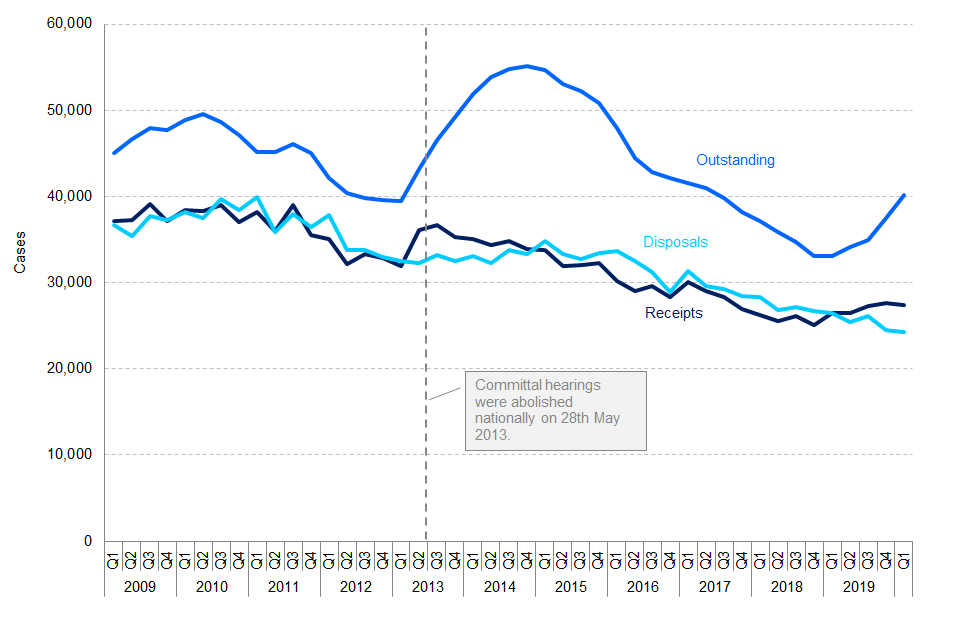
!!3
Crown court caseload (Table C1)
On 23rd March 2020 jury trials were suspended[footnote 5]. and the operational capacity of the court estate was reduced as part of the ongoing response to the COVID-19 pandemic. Although only accounting for just over one weeks’ worth of data for Q1 2020, COVID-19 has had an impact on the Crown Court caseload statistics. As a result, there has been a decrease in disposals and an increase in the number of outstanding cases in the Crown Court.
Case receipts and disposals have been stabilising over the past few years and were at very similar volumes, however, since Q1 2019 receipts have consistently been higher than disposals for the first time since 2014.
Compared to the previous year, the volume of cases received into the Crown Court has increased by 3% in Q1 2020, while disposals decreased by 8%.
-
The increase in receipts is due to an increase in triable-either-way cases being sent to the Crown Court, up 9% on the Q1 2019.
-
The decrease in disposals can be seen across all case types, with 10% decrease in ‘for trial’ disposals in Q1 2020. The decrease in disposals can be seen in the majority of offence groups, with the largest absolute falls seen in violence against the person and theft offences.
At the end of Q1 2020 there were around 40,173 outstanding cases at the Crown Court, an increase of 21% on Q1 2019 and the highest level seen since Q2 2017.
- The increase can be seen across all case types, except for appeals of magistrates’ decisions which fell by 7%. The increase in outstanding trial cases can be seen across all offence groups to varying degrees, with the largest proportional increase since Q1 2019 seen for drug offences (up 31%).
Figure 4: Outstanding for trial cases by selected offence groups, Q1 2010 – Q1 2020 (Source: cc_rdos_tool)
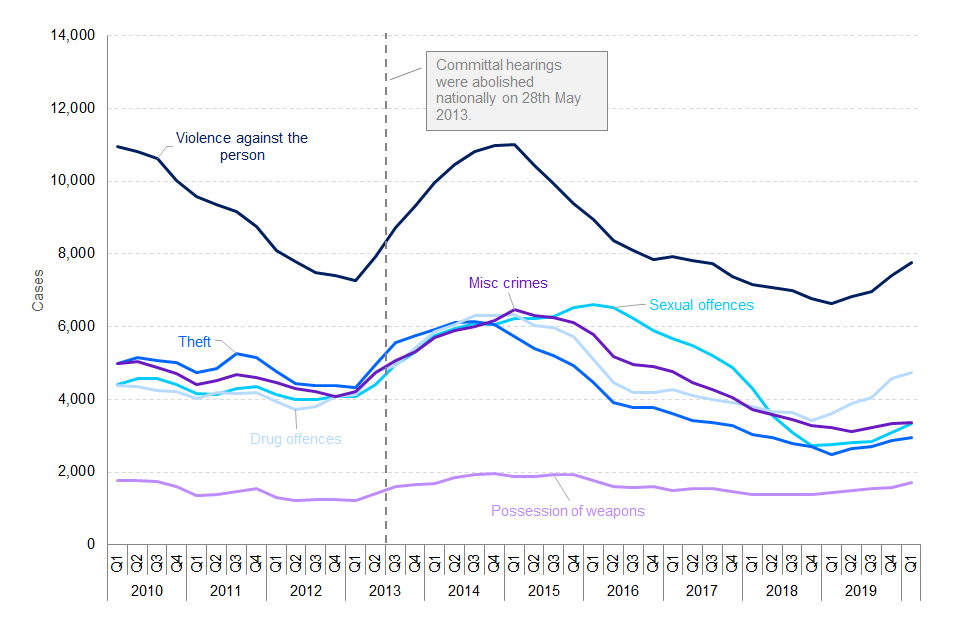
!!4
Trial efficiency
Although only accounting for just over one weeks’ worth of data for Q1 2020, COVID-19 has had an impact on the trial efficiency statistics.
Figure 5: Vacated trials at the Crown Court, Q1 2009 – Q1 2020 (Source: Table C2)
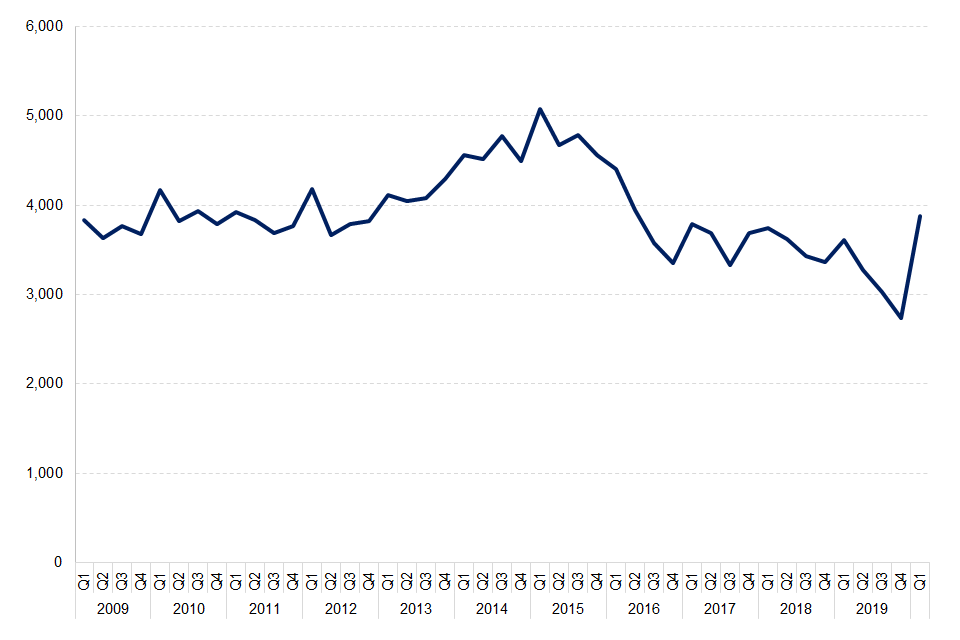
!!5
Following a decrease in the number of vacated trials throughout 2019, vacated trials have increased by 7% compared to Q1 2019 and 41% on Q4 2019 – back to levels seen in 2016. The proportion of ineffective trials at the Crown Court increased by 8 percentage points with a corresponding fall in effective (6 percentage points) and cracked trials (2 percentage points) compared to Q1 2019. The latest ineffective trial rate[footnote 6] (21%) is the highest level seen across the series (2009-2020).
Guilty plea rates
For defendants dealt with in trial cases at the Crown Court, the guilty plea rate[footnote 7] in Q1 2020 (70%) has increased by 3 percentage points compared to Q1 2019.
-
Of those entering a guilty plea, the majority continue to enter a plea ‘prior to trial’ (63%), up 3 percentage points on Q1 2019 (60%).
-
Where entering a guilty plea before trial, close to three-quarters enter a plea after one hearing (74%) – this has increased by 4 percentage points compared to the previous year and is a series high.
The largest increases (6 percentage points) in guilty plea rate were seen for possession of weapon offences and fraud offences, up to 70% and 68% respectively in Q1 2020.
Sexual offences remain the offence group with the lowest guilty plea rate but this increased to a series high in Q1 2020 (45%). The rate has increased in 2019 compared to an average of 35% between 2014 and 2018.
Average waiting and hearing time at the Crown Court
Overall, the median average waiting time[footnote 8] for defendants at the Crown Court decreased from 6.1 weeks to 5.7 weeks, it has more than halved since the series peak in Q2 2015 (13.0 weeks).
The median waiting time for defendants dealt with in trial cases fell by 17% compared to the Q1 2019 (13.1 weeks) to a series low of 10.9 weeks Q1 2020. For trials cases where a defendant pleads not guilty, the waiting time has remained broadly stable at around 24 weeks.
- Decreases in waiting times for trial cases can be seen across most offence groups, particularly for ‘miscellaneous crimes against society’ (down 37%) and ‘possession of weapons’ (down 33%). Sexual offences (20.2 weeks), violence against the person (18.7) and fraud offences (17.6) continued to have the highest trial waiting times.
The median hearing time[footnote 9] for trial cases has remained stable at around 1.2 hours. The average hearing time has changed very little across the series, ranging from 1.0 to 1.5 hours. For trials where a not guilty plea was entered, the median hearing time has decreased by 7% (to 7.2 hours), bringing it in line with durations last seen in 2014.
- In Q1 2020, the median hearing time for fraud offences and sexual offences fell by 27% and 21% respectively. Despite falling to a series low of 2.9 hours, sexual offences have the longest median hearing duration of all offences.
4. Timeliness
The COVID-19 pandemic has caused MoJ to have to change its data gathering, access and release practices, focusing efforts on priority analysis and statistics. Our statement explains this further. Of particular note, we have temporarily paused access to the Police National Computer, to minimise non-essential travel by our analysts.
As a result, and in line with guidance from the Office for Statistics Regulation, the decision has been made to delay the publishing of all linked end-to-end criminal court timeliness data in this publication. We will keep users updated of any further changes via our published release calendar.
It has not been possible to produce updated criminal court timeliness estimates for Q1 2020 and data to the end of December 2019 remains the latest available estimates.
We will continue to review access arrangements and keep users informed as developments unfold ahead of the next planned release in September 2020. We remain committed to providing the best and most accurate information we can, serving the public good at a time when it is needed the most.
5. Juror statistics
The number of jurors summonsed fell between 2018 and 2019.
Around 347,000 jurors summons were issued in 2019, a decrease of 4% on 2018. The juror utilisation rate continued to fall, down to 65% in 2019.
The number of juror sitting days decreased by 14% in the latest year, to a series low of 784,087 in 2019. Since 2014, the juror utilisation rate[footnote 10] has been falling year-on-year – this continued in 2019 with a rate of 65%.
Fewer jurors summonsed were disqualified from serving in 2019 compared to 2018, with a decrease of 8,470 (9%). This follows a general downward trend in the number of disqualifications since a peak in 2008.
Figure 6: Juror sitting days and juror utilisation rate, 2006 - 2019 (Source: Table J2)
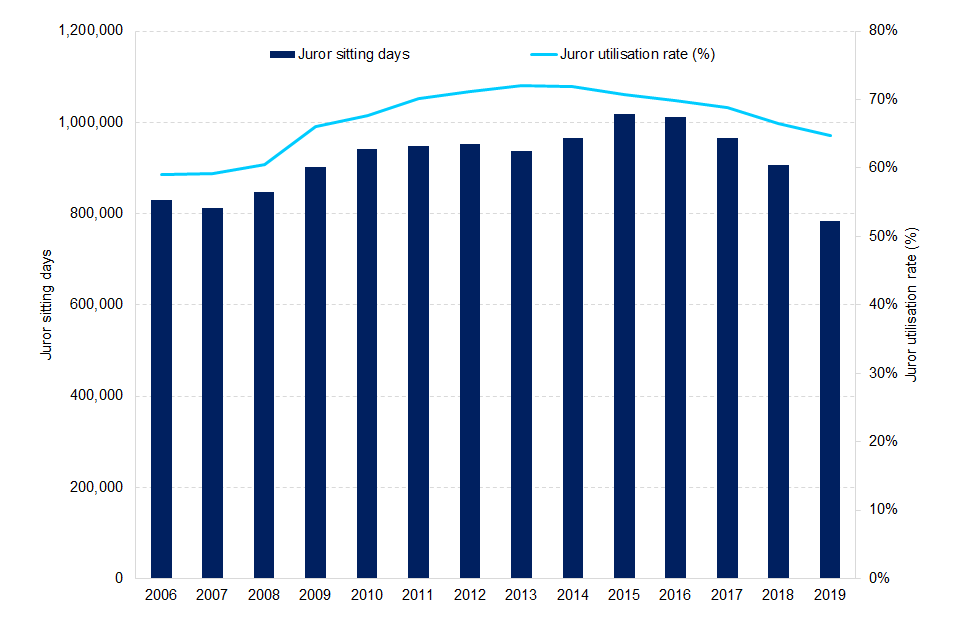
!!6
The Criminal Court Statistics Quarterly publication covering Q2 (April-June) 2018 included a table titled ‘Jury summoning figures in the Crown Court by age group,’ for the first time, which detailed an age breakdown of jurors and whether they served, did not serve, were disqualified or did not respond. Discrepancies between the juror summons age-group breakdown and the overall juror summonsing estimates have since been identified as part of routine checks for the latest publication. As a result, a decision has been made by the Head of Profession for Statistics to remove the juror age-group estimates from the latest published statistics until further reassurance can be sought. We will continue to investigate the quality of the underlying data and methodologies used with data suppliers and system owners to better understand the identified discrepancies.
6. Enforcement of financial impositions
Total financial impositions fell slightly in Q1 2020
Total financial impositions fell to £143.5m in Q1 2020, down by 7% compared with Q1 2019. The total value of outstanding financial impositions remained at £1.21 billion in Q1 2020.
Figure 7: HMCTS management information: Financial impositions by imposition type, England and Wales, Q2 2011 – Q1 2020 (Source: Table A2)

!!7
Financial impositions and amounts paid by imposition type
The overall value of impositions fell by around £11.2m on Q1 2019, this is largely due to decreases in fines. The value of total fines imposed fell by £6.1m, down 6% compared with Q1 2019.
Outstanding financial impositions
In Q1 2020, the total value of financial impositions outstanding in England and Wales was £1.21 billion, up 6% on Q1 2019.
The amount of outstanding financial impositions has doubled since the start of 2015 (£571m). A change in policy regarding the collection of financial impositions is partially behind this cumulative increase – unpaid accounts are no longer routinely closed and therefore, more outstanding impositions are carried over from previous periods.
7. Experimental Statistics – language interpreter and translation services
The number of completed language service requests has increased and the success rate[footnote 11] remained broadly stable[footnote 12]
The success rate of requests has remained stable compared to Q1 2019, at 97%, whereas the number of completed requests has increased by 5% over the same period.
Completed service requests
The number of completed service requests in Q1 2020 (44,184) increased by 5% compared to Q1 2019, a series high under the new contract (since Q4 2016).
Criminal court requests continue to account for the largest proportion of completed language service requests (42% in Q1 2020). There have been increases in completed requests for criminal (5%) and civil and family (8%), whereas there has been a decrease of 3% in tribunal completed requests compared to Q1 2019.
Figure 8: Number of completed language service requests and overall success rate, Q1 2013 – Q1 2020 (Source: Table L1)

!!8
Success rate
The overall success rate of requests was 97% in Q1 2020 and has remained broadly stable since 2017, between 96% and 98%. The success rate for non-DPSI[footnote 13] languages has remained the lowest of all service types since Q4 2016. In Q1 2020 it was 86%, compared to 98% for standard languages and 96% for special services.
Complaints and complaint rate
The number of complaints has increased from 381 in Q1 2019 to 436 in Q1 2020, but this has fallen on Q4 2019 (456). Despite the increase in the number of complaints, the complaint rate remained stable at 1%.
Tribunals continue to be the largest contributing requester type receiving complaints (49%) despite only accounting for 28% of total service requests in Q1 2020.
In Q1 2020, the largest complaint category was ‘operational issues’, accounting for 29% of complaints, followed by ‘interpreter was late’ (22%) and ‘no interpreter available (19%).
‘Off-contract’ requests
The number of ‘off-contract’ requests in Q1 2020 increased, up 8% compared to the Q1 2019, from 627 to 676. The current levels have fallen from a peak in Q3 2019, which saw the highest volume of ‘off-contract’ requests since the introduction of the new contract (778).
In Q1 2020, the majority of ‘off contract’ requests were made by tribunal courts (59%). The increase in tribunals since the end of 2018 is mostly attributed to the increase in the number of requests involving immigration tribunals.
8. Annex: Preliminary analysis of management information.
Impacts of COVID-19 guidelines and regulations on criminal court trends, January – May 2020
To address growing public interest and provide more timely information on the immediate impacts of the COVID-19 pandemic on the criminal court, provisional statistics covering January to May 2020 are being included in this annex.
This analysis should be treated as provisional information providing a top-level estimate of emerging weekly criminal court volumes and trial efficiency, up to the end of May 2020. Magistrates’ courts estimates are sourced from the published HMCTS management information and relate to all cases heard (not just criminal) and as such these differ markedly from the published criminal courts estimates (e.g. Table M1).
The Crown Court information has been produced by MOJ statistics and the methodology and counting rules are broadly comparable to those in the main report[footnote 14].
This data has not been through the same level of data validation and is based on an earlier extract than those routinely released in the National Statistics - it should therefore be treated as preliminary and indicative only[footnote 15]. As a result of this, data can only be presented at aggregated levels and revisions are expected to the weekly estimates in future.
Criminal court caseload
Figure 9a: Index of weekly receipts, disposals and outstanding cases at magistrates’ court, Mar to May 2020
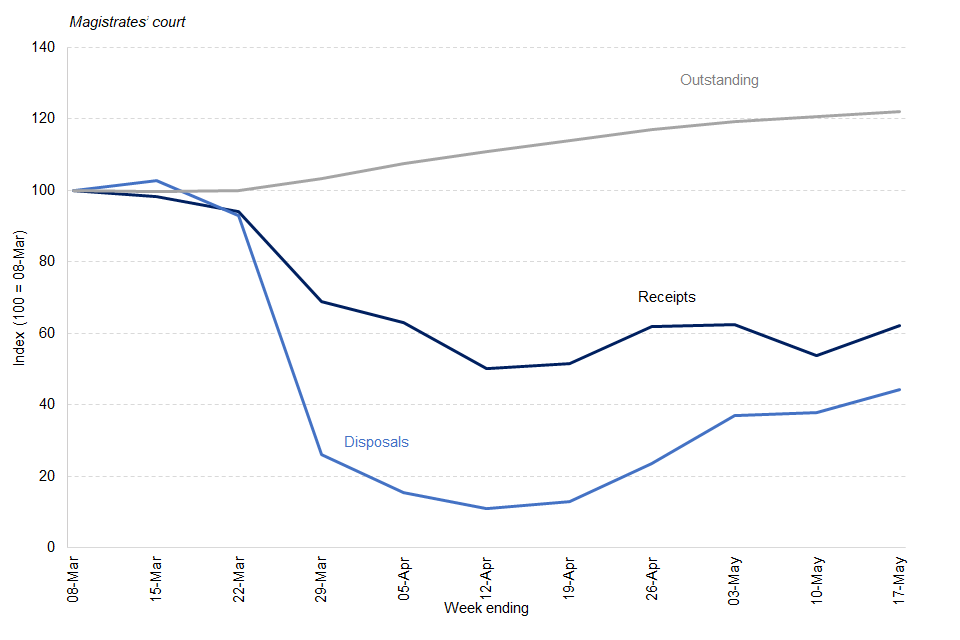
!!9
Figure 9b: Index of weekly receipts, disposals and outstanding cases at Crown Court, Mar to May 2020
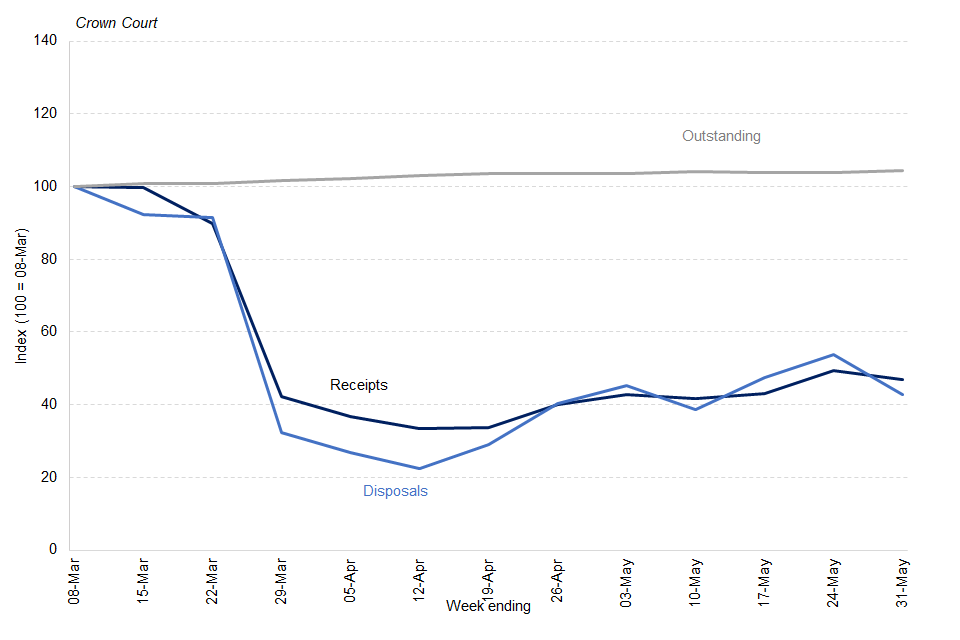
!!10
Magistrates’ court
From the week ending 29th March 2020, the number of receipts and disposals at the magistrates’ court fell sharply and remained at these low levels until mid-to-late April.
The number of outstanding cases increased to around 484,000 cases, up 22% between the week ending 8th March and 17th May 2020 following the review of court arrangements announced by the Lord Chief Justice[footnote 16].
Volumes of receipts and disposals have tended to gradually increase since mid-to-late April, but remain below levels seen in early March 2020.
Crown Court
The number of receipts and disposals at the Crown Court had been stable between January 2020 and 22nd March 2020 (averaging around 2,200 receipts and 2,000 disposals).
The number of receipts and disposals fell sharply, down 53% and 57% respectively between the week ending 8th March and 31st May 2020. The number of outstanding cases increased by 4% over the same period to around 41,000 cases, continuing increases seen since December 2019.
Volumes of receipts and disposals have tended to gradually increase since mid-to-late April, true for both trial and sentencing cases – but levels remain below those seen between January and 23rd March 2020. Future Crown Court caseload trends are likely to be influenced by the recovery in disposals from the magistrates’ court.
Trial efficiency
The number of vacated trials increased sharply as a result of the review of court arrangements and the temporary pausing of jury trials at the Crown Court.
Figure 10: Weekly effectiveness of Crown Court trials, Jan – May 2020
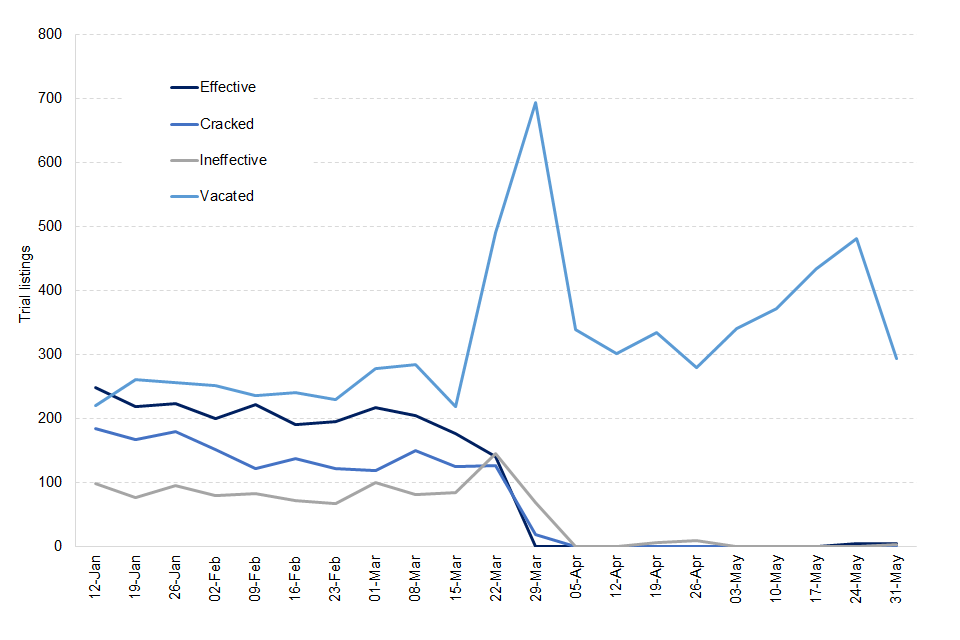
!!11
On average around 250 trials were vacated per week between January and 22nd March, this has increased to around 400 between 29th March and 31st May 2020, with a peak in the week ending 29th March 2020.
Vacated trials are trials which have been removed from the listing before the date of the trial. Vacated trials are counted in the period the vacation happened rather than the date when they were due to be listed (e.g. as for effective, cracked and ineffective estimates).
Trial levels remain historically low but jury trials have resumed in a small number of Crown Court in late-May 2020.
Further information on criminal court caseload and trial efficiency to the end of June 2020 is scheduled to be published on 24th September 2020. We will consider what additional information could be included in those publications. In the meantime, HMCTS regularly publish high-level Management Information covering all jurisdictions here: https://www.gov.uk/government/collections/hmcts-management-information.
9. Further information on criminal courts data
The latest data presented in this publication are provisional. Final data for each calendar year is published in June, following further data cleaning and the incorporation of additional cases not available in our original extracts.
Accompanying files
As well as the bulletin, the following products are published as part of this release:
-
Two technical guides providing background information and standalone quality guide.
-
A set of overview tables, covering each section of this bulletin.
-
Pivot tools and underlying data which feature further breakdowns of published data.
National Statistics status
National Statistics status means that official statistics meet the highest standards of trustworthiness, quality and public value. This bulletin recently underwent a compliance check with the Office for Statistics Regulation and retained its National Statistics status in January 2019[footnote 17]. All official statistics should comply with all aspects of the Code of Practice for Statistics. They are awarded National Statistics status following an assessment by the Authority’s regulatory arm which considers whether the statistics meet the highest standards of Code compliance, including the value they add to public decisions and debate. It is the Ministry of Justice’s responsibility to maintain compliance with the standards expected for National Statistics. If we become concerned about whether these statistics are still meeting the appropriate standards, we will discuss any concerns with the Authority promptly. National Statistics status can be removed at any point when the highest standards are not maintained, and reinstated when standards are restored.
Experimental Statistics status
Experimental statistics are produced under the remit of the Code of Practice for Statistics. They are also produced impartially and are free from political influence[footnote 18].
Future publications
Our statisticians regularly review the content of publications. Development of new and improved statistical outputs is usually dependent on reallocating existing resources. As part of our continual review and prioritisation, we welcome user feedback on existing outputs including content, breadth, frequency and methodology. Please send any comments you have on this publication including suggestions for further developments or reductions in content to the contacts listed below.
Contact
Press enquiries should be directed to the Ministry of Justice press office:
Tel: 020 3334 3536
Email: newsdesk@justice.gsi.gov.uk
Other enquiries about these statistics should be directed to the Justice Statistics Analytical Services division of the Ministry of Justice:
Damon Wingfield, Responsible Statistician and Head of Criminal Justice System Statistics
Ministry of Justice, 3rd Floor, 10 South Colonnade, London, E14 4PU
Email: statistics.enquiries@justice.gsi.gov.uk
Next update: 24th September 2020
URL: https://www.gov.uk/government/statistics/criminal-justice-system-statistics-quarterly-december-2018
© Crown copyright Produced by the Ministry of Justice
Alternative formats are available on request from statistics.enquiries@justice.gsi.gov.uk
-
https://www.gov.uk/guidance/hmcts-weekly-operational-summary-on-courts-and-tribunals-during-coronavirus-covid-19-outbreak ↩
-
https://www.judiciary.uk/announcements/jury-trials-to-resume-this-month/ ↩
-
For more information relating to the impact of the administrative changes at the Crown Court please refer to the Criminal court statistics quarterly Q4 2019 report ↩
-
https://www.judiciary.uk/announcements/review-of-court-arrangements-due-to-covid-19-message-from-the-lord-chief-justice/ ↩
-
https://www.judiciary.uk/announcements/review-of-court-arrangements-due-to-covid-19-message-from-the-lord-chief-justice/ ↩
-
Ineffective trial rate is calculated as the proportion ineffective trials over the total number of trials due to be heard in a given period (e.g. sum of effective, cracked and ineffective). ↩
-
Guilty plea rate is the number of defendants pleading guilty to all counts as a proportion of all those with a plea. ↩
-
The waiting time is the duration in weeks between a case being sent to the Crown Court and the first main hearing. A value is determined for each defendant dealt with during the period and averages calculated. ↩
-
The average hearing time is calculated as the total sum of all hearings in all cases divided by the number of cases - this represents the average time of all hearings combined in a case rather than a single hearing. ↩
-
Juror utilisation rate is calculated as the number of sitting days divided by the sum of sitting, non-sitting and non-attendance days. ↩
-
The statistics under the new contracts are ‘Experimental Statistics’ – the series remains in the testing phase and is not yet fully developed. ↩ ↩2
-
The number of requests that were fulfilled divided by the total fulfilled and unfulfilled (excludes cancelled requests) ↩
-
The Diploma in Public Service Interpreting (DPSI) is a standard qualification required of interpreter; languages covered by it are termed ‘Standard’ languages. Those not covered in the DPSI require separate qualifications and are termed ‘non-DPSI’ languages ↩
-
See the supporting guidance documentation for further details: https://www.gov.uk/government/publications/a-guide-to-criminal-court-statistics ↩
-
These figures are subject to revisions. ↩
-
https://www.judiciary.uk/announcements/review-of-court-arrangements-due-to-covid-19-message-from-the-lord-chief-justice/ ↩
-
https://www.statisticsauthority.gov.uk/correspondence/compliance-check-on-court-statistics/ ↩
-
https://www.statisticsauthority.gov.uk/monitoring-and-assessment/code-of-practice/ ↩
